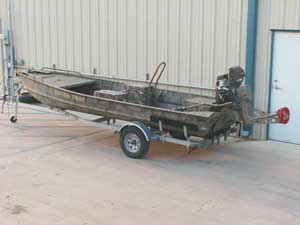
After Katrina and Rita, experts predicted several lean duck years, but the habitat has rebounded remarkably well, and this season may be one for the ages.
Duck season opens this month, and I was wondering how many of you have thought of doing any maintenance on your duck hunting boats and motors. I just cannot think of anything worse than arriving at your favorite launch site at 3 or 4 a.m., launching your boat, loading all your hunting gear and then finding out that the motor will not start.
Maybe it does start; you make it about half way to your hunting lease and the engine begins to spit and sputter and kills. Now you have to wait until daylight, and hope that someone comes along to tow you back to the launch.
Duck season is only 60 days long. You cannot afford to be wasting your hunting days like this.
The sad thing is that many times the above scenario could have been avoided with some simple maintenance and tender loving care for your engine.
A lot of the maintenance for your mud motor is the same as it would be for your outboard motor. Start with the battery; remove the terminals and clean both the battery post and the terminals with a wire brush. If you have a battery load tester, check the battery’s cranking amperage to see if it is fully charged. If you do not have such a tester, many automotive parts stores will perform that test for you if you bring the battery to them.
If the battery is weak, charge it and recheck with the load tester. If it is still weak, replace the battery, or if it is good, reattach the wires and be sure to tighten the wing nuts using a pliers or wrench. Finger-tight wing nuts will usually cause problems.
If you need a new battery, insist on a quality marine battery. Those discount specials usually will not hold up well in a boat.
Most mud motors are only used during duck season, and they are put in storage for the remainder of the year. This can cause problems with the engine’s fuel system.
Start by draining the fuel tank. Take that old gas to a recycle facility to be properly disposed. Once the gas tank is drained, inspect the inside of the tank for any residue from the old fuel. If there is residue, clean the inside of the tank with a mild solvent.
If you cannot get the tank clean, replace it with a new one. Remember that the contamination you found in the tank may also be in the fuel lines and filters. Clean out the lines and replace the filters.
After everything is cleaned, fill the tank with fresh gas, and crank up your engine. If the engine runs well, move onto the rest of the maintenance items. If the engine does not run, you will have to determine if the problem is ignition-related or possibly due to a dirty carburetor. If needed, you can disassemble the carburetor and soak the pieces in carburetor cleaner, then reassemble with new gaskets.
Once you have verified that the engine will run, it is time to move on to general maintenance. I like to start with a fresh set of spark plugs, and change the oil and filter in the engine.
The mud motor frame package will also require some attention. Depending on the brand of mud motor you have, you may need to grease the drive shaft tube or on some units you actually have a lower unit filled with oil that will need to be drained and changed. Don’t forget the easy-to-overlook items such as grease fittings for the tilt and steering pins on the engine.
It would be a good idea to remove the propeller from the shaft and check for any damage to the prop shaft seals. If the shaft seals are good, lubricate the shaft with never-seize, and reinstall the prop.
While you have the propeller removed, check the condition of the blades. If your propeller blades become worn down, bent or frayed along the edges, it will not perform like it did when it was new. Now would be the perfect time to replace that worn propeller with a new one and perhaps keep the old one as a spare in the boat.
Mud motors are designed to take a lot of abuse, and duck hunters seem to be experts when it comes to abusing these motors. Remember that anything made by man can be broken or damaged. Check the entire engine frame, look for any impact damage such as cracked welds or loose pivot joints for steering and tilt. Check the prop shaft to be sure it has not been bent. If your engine is equipped with universal joints, check them for slack or wear.
Once you have completed all of the maintenance, you should consider taking the boat out on the water for a shakedown cruise. Just take it to your nearest launch and go for a nice, long boat ride. While you are out there on the water, you can observe your engine in action and be assured that everything is working properly. If something is not performing as it should, make a note of it so you can correct it when you get back home. Hopefully this preparation and effort will pay off in a trouble-free hunting season.
If you have any questions about your boat, motor, or trailer, send me an e-mail at hanktheboatdr@yahoo.com.


